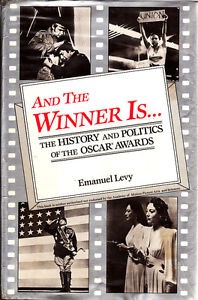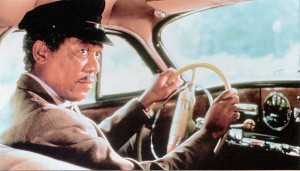Reviews of the worst winners of the Best Picture–chronologically.
Hey, don’t get upset! It’s a matter of taste, and we all love some bad movies, not to mention the fact that a flawed picture might still have some good moments, a powerful performance, impressive cinematography, melodic score, stirring visual or sound effects.
The list of mediocre films that have won Best Picture is much longer than the list of bad ones.
Below please find my list of the worst winners:
The first bad film to win the Best Picture is Broadway Melody (1929).
The second bad film to win is: Cimarron (1931).
The third bad film to win is: The Great Ziegfeld (1936).
The fourth bad film to win is: Mrs. Miniver (1942).
The fifth bad film to win is: The Greatest Show on Earth (1952).
The sixth bad film to win is: Around the World in 80 Days (1956).
The seventh bad film to win is: Kramer Vs. Kramer (1979).
The eighth bad film to win is: Terms of Endearment (1983).
The ninth bad film is: Driving Miss Daisy (1989).
Our Grade: B- (** out of *****)
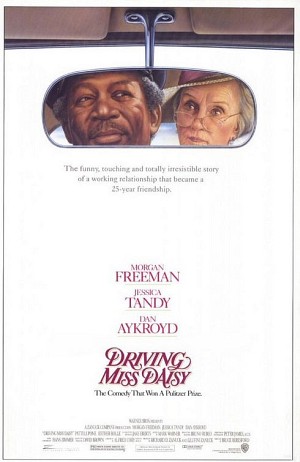
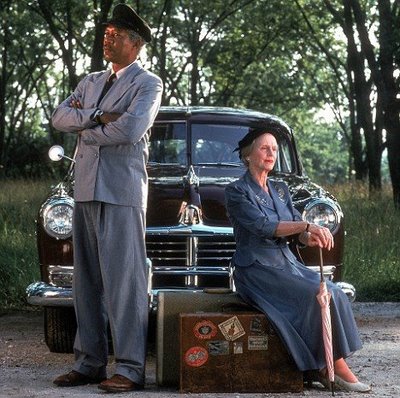
Dan Aykroyd is cast against type in an unusual “straight” role as Daisy’s son, Boolie, which may explain why he earned an Oscar nomination (his first and only one to date).
I have drawn elsewhere comparisons between Driving Miss Daisy and Green Book, another interracial tale with an explicit (borderline banal) message. Unfortunately, Green Book is a frontrunner for the 2019 Best Picture Oscar, and if it wins, it would be a companion piece to the 1989 movie.
Tandy plays Mrs. (“Miss”) Daisy Werthan, a 72-year-old wealthy white Jewish widowed, who was once a school teacher. She lives alone in Atlanta, Georgia, except for an African American housemaid named Idella (Esther Rolle). When Miss Daisy wrecks her car, her son Boolie (Aykroyd), hires Hoke Coleburn (Freeman), a chauffeur who drove for a local judge until he recently died. Miss Daisy refuses to let Hoke drive her, but gradually starts to accept him.
When Miss Daisy realizes that Hoke is illiterate, she teaches him how to read. As Miss Daisy and Hoke spend time together, she gains appreciation for his other skills and the two become friends. After Idella dies in 1963, rather than hire a new maid, Miss Daisy decides to care for her own, and Hoke assists with the cooking; the two plant a vegetable garden.
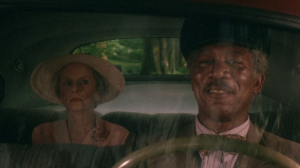 The film exposes the racism and prejudice that permeated American society, such as when Alabama highway patrolmen make bigoted comments about Miss Daisy’ religion and Hoke’s race.
The film exposes the racism and prejudice that permeated American society, such as when Alabama highway patrolmen make bigoted comments about Miss Daisy’ religion and Hoke’s race.
After the synagogue is bombed, Miss Daisy realizes that she is also the victim of prejudice. Miss Daisy attends a dinner at which Dr. Martin Luther King gives a speech. She initially invites Boolie to the dinner, but he declines, and suggests that Miss Daisy invite Hoke. However, Miss Daisy only asks him to be her guest during the car ride to the event and ends up attending the dinner alone. Hoke is insulted by the manner of the invitation, opting to listen to the speech on the car radio.
In 1971, Miss Daisy showing signs of dementia, and Hoke, always caring and alert, declares his loyal friendship. Boolie puts Daisy in a retirement home, and Hoke, now 81, retires.
Boolie and Hoke drive to the retirement home to visit Miss Daisy, who is now 97.
In the last image, as Hoke feeds her and reminisces about the good old times together, a car is seen driving into the distance.
Oscar Context:
The film received nine nominations, winning four: Best Picture, Actress, Adapted Screenplay, and Makeup. Driving Miss Daisy had no violence and no sex-it was a middlebrow movie about virtues and decent values.
The film’s low budget ($7.5 million), and the fact that it was made without big-name stars, must have commanded the Academy members’ attention.
Producer Zanuck observed after winning: “Anything that tugs at your heart and emotions has a good chance for the Best Picture.” Unfortunately, she was right. But what about artistic quality?
Driving Miss Daisy broke a number of records. It is the only film based on an off Broadway production to have won the Best Picture.
It is also the last Best Picture winner to receive a PG rating.
Oldest Best Actress?
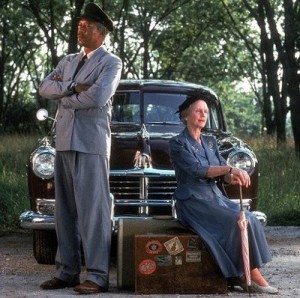 At 81, Jessica Tandy became the oldest winner in the history of the Best Actress category. However, Tandy is not the oldest winner; Christopher Plummer claims the title, winning the Best Supporting Actor Oscar, for Beginners, at 82.
At 81, Jessica Tandy became the oldest winner in the history of the Best Actress category. However, Tandy is not the oldest winner; Christopher Plummer claims the title, winning the Best Supporting Actor Oscar, for Beginners, at 82.
Oscar Nominations: 9
Picture, produced by Richard D. Zanuck and Lili Fini Zanuck
Screenplay (Adapted): Alfred Uhry
Actress: Jessica Tandy
Actor: Morgan Freeman
Supporting Actor: Dan Aykroyd
Art direction-set decoration: Bruno Rubeo; Crispian Sallis
Film Editing: Mark Warner
Costume design: Elizabeth McBride
Makeup: Manlio Rocchetti, Lynn Barber, and Kevin Haney
Oscar Awards: 4
Picture
Actress
Screenplay
Makeup
Oscar Context
The most nominated film in 1989, “Driving Miss Daisy,” received four Oscars out of its 9 nominations, including Picture, Screenplay, and Actress. The biggest scandal was that the film’s director, Bruce Beresford, failed to receive recognition from his peers in the Directors Branch.
It was not a particularly year in terms of artistic quality. The other Best Picture nominees represented a mixed bag in genre and quality: Oliver Stone’s Vietnam drama “Born on the Fourth of July,” with 8 nominations, including Best Actor for Tom Cruise, “My Left Foot” with 5, with a brilliant turn from Daniel Day-Lewis, “Dead Poets Society” with 4, and “Field of Dreams” with 3.
Cast
Miss Daisy Werthan (Jessca Tandy)
Hoke Colburn (Morgan Freeman)
Boolie Werthan (Dan Aykroyd)
Florine Werthan (Patti LuPone)
Idella (Esther Rolle)
Mis McClatchey (Joann Havrilla)
Oscar (William Hall Jr.)
Dr. Weil (Alvin M. Sugraman)
nonie (Clarice F. Geigerman)
Miriam (Muriel Moore)
Credits:
Warner release
Zanuck Company Productions
